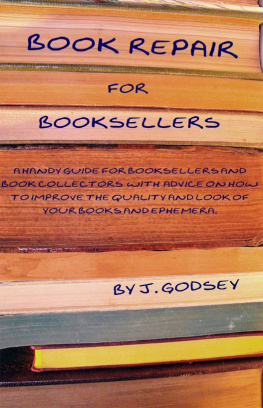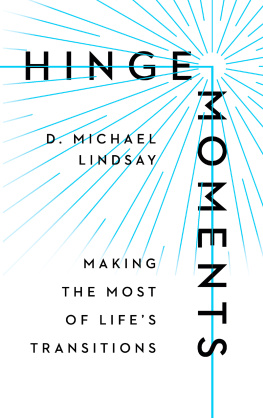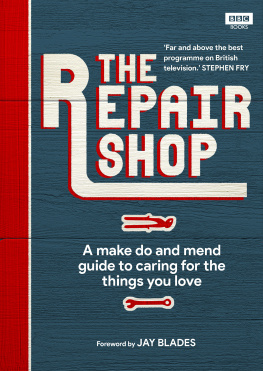Book Repair forBooksellers
A handy guide forbooksellers and book collectors offering practical advice on how toimprove the quality and look of your books and ephemera
by J. Godsey
2009, 2013 J Godsey &SicPress.com
14 Pleasant St.
Methuen,Massachusetts.
sales@sicpress.com
SmashwordsEdition
All rights reserved. Nopart of this book may be reproduced or transmitted in any form orby any means, electronic or mechanical, including photocopying,recording, or by any information storage and retrieval system,without written permission from the author or publisher, except forthe inclusion of brief quotations in a review, article, book, oracademic paper
Table of Contents
Preface
Book repair for booksellers. Traditionally there are two types of book repair books: thosewhere the end goal is to prepare the book for further intensecirculation, and thus aesthetics take a backseat to durability; andthose that focus on archival preservation and restoration of booksof historical or monetary value. This leaves booksellers wanderingin the desert, with a stack of books that arent valuable enough tosend out for professional restoration, yet are too good todiscard.
I have seen books repaired with book tape,duct tape, electric tape, and masking tape. I have seen rubbercement, white glue, airplane glue, superglue, and hot glue. I haveseen them priced with stickers, ink, crayon, marker, and lipstick.And I have been asked to remove every bit of it. Some of thesemutilations were done by people I know and respect in the field. Ihave even done a few myself: I did library-type repairs on books inhigh school and have been paying penance ever since.
I know a bookbinder who sells bottles offurniture polish and neatsfoot oil and calls it book crme. Iknow another who buys saddle polish and relabels it as a leatherbook treatment. And I know a bookstore that uses electrical tapeto reback reading copies. There are better and less dangerousmethods of repair however that are just as easy.
I will admit that not every book deservesarchival quality treatment. That inexpensive copy of a book clubbestseller without a dust jacket deserves a spiffy new outlook onlife, but not to the extent of spending an hour of my life drycleaning and redyeing it.
If you have 30 dollars into a 100 dollarbook, you dont want to spend another 75 on a full-boat restorationwhen a 25 buck reback will do. Take the time to learn which booksnot to harm and you wont have to worry about what happens to abook you sold 40 years down the road.
When should a book be sent out for repairsand when should you work on it yourself?
If you dont know thebooks true value, STOP.
If you think you mayharm it, STOP.
If you arent sure whatits going to look like later, STOP.
If you cant afford tothrow it away after you have ruined it, STOP.
Use your head before youuse your hands. One can easily turn a goodbook into scrap paper. It is assumed that you have researchedthe damaged book and found it not valuable enough to demand repairby a professional. It is more workfor the conservator to correct a bad repair than to just start fromscratch. If the book has great monetary or sentimental value, it isprobably best left as is or restored by aprofessional.
When in doubt: DONOTHING. Give it a once over for 10minutes then sell it as is. Doing nothing is the safest course ofaction. Doing repairs that keep small injuries from becoming bigones is even better.
Respect the book. Dont use products that arent meant to be usedon books, such as superglue, hot glue,epoxy, or duct tape. If you dont respect the integrity of thebook, you are in the wrong business. For example, I saw a nicefirst edition at a book show where the endpapers had been so badlyreplaced that the book was now practically worthless sincereversing the bad repair would have caused even moredamage.
Do what you feelcomfortable doing. You can do fixes thatcant be reversed on books that are never going to increase invalue. But if it may increase in value, dont mess with it unlessyou know what you are doing. Start small: facelifts, erasing,lifting stickers, tipping in pages, tightening spines. Mostimportantly, practice new methods first on worthless books, thatswhat they are for!
Do the math. Book A is worth $25 in GOOD condition. If itneeds anything that takes longer than 10 minutes, it is not worthdoing. Things you can do in 10 minutes: erasing, remove stickers,surface cleaning, fix tears and loose pages. If you spent 1 hour onit, and you sold it immediately, you wont even be breakingeven.
Book B in GOOD condition would bring $75. Ifit needs a total rebind, it is worthless give it away. If itmerely needs rebacking, but then is worth only a fraction, sell itas is, and let the end user worry about fixing it.
Book C is worth $250 in GOOD condition andyou have less than $100 into it already. Do the 10 minute repairsyourself. If it needs a reback and you KNOW how, you can do that.If you are adept at major repairs, you can do them, but rememberyour TIME is worth something. And most booksellers dont have theTIME to do major repairs themselves. If it needs major repairs andyou cant do them, sell it as is, let the customer spend the doughon a repair. Sending it out to be fixed will eat into your profitstoo much.
Send it out. If the book is worth more than $250, send it toa professional or sell it as is. When youpay for a book to be repaired, you will have to work the costs ofthe repair into your sale price. If you dont have a ready customerfor it, you may have to wait awhile to get that money back.Sometimes forever. Most high end sellers will easily spend money onwhat needs doing, because once they can display the book, they cangenerate interest in it. If it is damaged, they can only talk aboutit.
If you only list on databases and the bookwill SIT waiting to sell, dont bother, sell it as is. If you haveto hang on to it for a year, you have tied your money up paying forsomething that your customer could have paid for. If someone isinterested in it, offer to send it to a binder for them and havethem pick up the tab.
Library discards. Most library discards are not valuable; the largepercentage are little more than reading copies and cleaned up canserve as very nice shelf copies. A very small percentage are booksthat are scarce in any condition and with a little bit of carefulattention can be greatly enhanced. However, there are a minutenumber of books that should not be fixed by an amateur. It isexpected that you have researched your books and know thedifference between books you can work on yourself and books youshould send to a professional.
Price fairly. For a flawed book, I suggest you do your researchand come up with a price you feel comfortable with but can easilyget. You will likely only get a fraction of the value of a flawlesscopy (depending on the rarity of the title). If you hold out forthe best possible price you will probably end up owning the bookfor a very, very long time. Dont be greedy, since you dont have alot of money into the item, just get your money and getout.
Offer it to a few other sellers who carrysimilar books, and see if they are interested; if they come closeto your price, sell it. They know the market better than you do.Dont be surprised, however, if a high end seller isnt interestedin a flawed copy its nothing personal, it just wont fit intotheir catalog.
Throw it on an auction site and give thecollectors a chance at it. You may do much better, as collectorswho cant afford a perfect copy may see yours as a great bargain.You can even sit on the item for awhile; if you only have a fewdollars into it, why rush?
Be honest. If you have done anything beyond simple cleaningand erasing, tightening a hinge or tipping in a loose page, listthe repair in your description. If a torn page has been repairedand looks just dandy, say it has been professionally repaired. Ifthe book has been rebacked, rebound or had the endpapers replaced,you must declare it in your description or risk it beingreturned.
Next page










